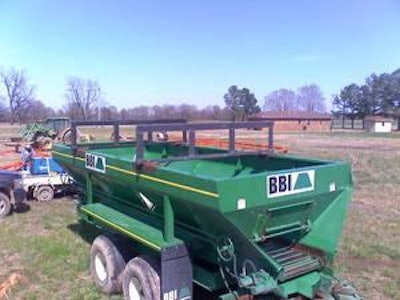
Poultry litter is a great organic fertilizer, but it smells, requires specialized equipment to spread and is not a highly concentrated source of plant nutrients. In short, poultry litter is more difficult and expensive to transport, store and apply than are chemical fertilizers. These factors have contributed to the low price, relative to the value of its nutrients, which growers receive for poultry litter.
Baling facilitates transport
Baling poultry litter is showing promise in Arkansas as a means of facilitating economical movement of poultry litter outside of environmentally challenged watersheds, according to Robert Bullock of White River Fertilizer Supply, who spoke at the National Meeting on Poultry and Animal Waste.
Using a machine originally designed to compress and bale trash in Europe, WRFS is baling and shrink wrapping, with ultraviolet light-protected plastic, compressed poultry litter at a facility near Fayetteville, Ark.
Round bales provide odor containment
Built-up litter from broiler or turkey houses is compressed to one-third of its original volume and formed in cylindrical or “round” bales weighing around 3,000 pounds each.
After baling, the litter goes through a heat or compost cycle lasting around 96 hours which kills all of the pathogens in the litter. The plastic wrap is not gas permeable, so the composting stops when the oxygen inside the bale is consumed. Odors and ammonia are also contained by the plastic wrap.
The plastic cover on the baled litter allows for outdoor storage of the litter for up to 18 months without environmental impact. This means that baled litter can be shipped year round and stored in the fields.
Special equipment needed
Picking up the bales without damaging the plastic cover requires special forks on a fork lift or tractor. WRFS can install these forks on equipment that has hydraulics for around $6,000. Cutting bars have been designed that can be mounted on litter spreaders for cutting the plastic wrap while dropping the litter into the spreader trailer or truck.
Transport cost and marketing
The cost of transporting poultry litter in a spreader truck or trailer is around $3.65 per mile in Arkansas versus $1.85 per mile for bailed litter on a flatbed trailer, according to Bullock.
WRFS has been able to economically market bailed litter as far as 400 miles from the bailer, which allows for phosphorous to be moved outside of challenged watersheds to areas where soils are deficient in phosphorous and there is a demand from crop farmers.
The company shipped 550 truckloads of baled litter out of northwestern Arkansas to Mississippi Delta row crop farms in the spring of 2010. End users saved 15% to 20% on the cost of nutrients for their soil versus what they would have paid for chemical fertilizer.
Business model
Bullock said that EPA has approved a process where poultry litter is mixed with dewatered biosolids from municipal wastewater treatment plants and then baled. WRFS will get a tipping fee for taking the biosolids and the compost cycle that takes place inside the bale allows for this material to be spread without a permit as is needed for Class B biosolids at the current time.
A litter bailing facility can be put together for around $1 million, according to Bullock. He said the second generation baler should be able to bale 40 tons of litter per hour.


















